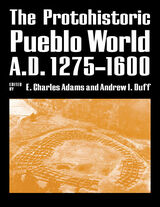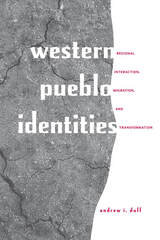2 books by Duff, Andrew I.

The Protohistoric Pueblo World, A.D. 1275-1600
Edited by E. Charles Adams and Andrew I. Duff
University of Arizona Press, 2004
In the centuries before the arrival of Europeans, the Pueblo world underwent nearly continuous reorganization. Populations moved from Chaco Canyon and the great centers of the Mesa Verde region to areas along the Rio Grande, the Little Colorado River, and the Mogollon Rim, where they began constructing larger and differently organized villages, many with more than 500 rooms. Villages also tended to occur in clusters that have been interpreted in a number of different ways. This book describes and interprets this period of southwestern history immediately before and after initial European contact, A.D. 1275-1600—a span of time during which Pueblo peoples and culture were dramatically transformed. It summarizes one hundred years of research and archaeological data for the Pueblo IV period as it explores the nature of the organization of village clusters and what they meant in behavioral and political terms. Twelve of the chapters individually examine the northern and eastern portions of the Southwest and the groups who settled there during the protohistoric period. The authors develop histories for settlement clusters that offer insights into their unique development and the variety of ways that villages formed these clusters. These analyses show the extent to which spatial clusters of large settlements may have formed regionally organized alliances, and in some cases they reveal a connection between protohistoric villages and indigenous or migratory groups from the preceding period. This volume is distinct from other recent syntheses of Pueblo IV research in that it treats the settlement cluster as the analytic unit. By analyzing how members of clusters of villages interacted with one another, it offers a clearer understanding of the value of this level of analysis and suggests possibilities for future research. In addition to offering new insights on the Pueblo IV world, the volume serves as a compendium of information on more than 400 known villages larger than 50 rooms. It will be of lasting interest not only to archaeologists but also to geographers, land managers, and general readers interested in Pueblo culture.
[more]

Western Pueblo Identities
Regional Interaction, Migration, and Transformation
Andrew I. Duff
University of Arizona Press, 2002
Identifying distinct social groups of the past has always challenged archaeologists because understanding how people perceived their identity is critical to the reconstruction of social organization. Material culture has been the standard measure of distinction between groups, and the distribution of ceramics and other artifacts has often been used to define group boundaries. Western Pueblo Identities argues that such an approach is not always appropriate: demographic and historical factors may affect the extent to which material evidence can define such boundaries. Andrew Duff now examines a number of other factors—relationships among settlement size, regional population densities, the homogeneity of material culture, and local and long-distance exchange—in order to trace the history of interaction and the formation of group identity in east-central Arizona and west-central New Mexico from A.D. 1275 to 1400.
Using comparative data from the Upper Little Colorado and Zuni regions, Duff demonstrates differences in patterns of interaction within and between regions with different population densities. He then links these differences to such factors as occupational history, immigrant populations, the negotiation of social identities, and the emergence of new ritual systems. Following abandonments in the Four Corners area in the late 1200s, immigrants with different historical backgrounds occupied many Western Pueblo regions—in contrast to the Hopi and Zuni regions, which had more stable populations and deeper historical roots.
Duff uses chemical analyses of ceramics to document exchange among several communities within these regions, showing that people in less densely settled regions were actively recruited by residents of the Hopi and Zuni regions to join their settlements. By the time of the arrival of the Spaniards, two distinct social and territorial groups—the Hopi and Zuni peoples—had emerged from this scattering of communities. Duff's new interpretations, along with new data on ceramic exchange patterns, suggest that interaction is a better way to measure identity than more commonly used criteria. His work offers new perspectives on the role of ritual in social organization and on identity formation in Pueblo IV society and is rich in implications for the study of other sedentary, middle-range societies.
Using comparative data from the Upper Little Colorado and Zuni regions, Duff demonstrates differences in patterns of interaction within and between regions with different population densities. He then links these differences to such factors as occupational history, immigrant populations, the negotiation of social identities, and the emergence of new ritual systems. Following abandonments in the Four Corners area in the late 1200s, immigrants with different historical backgrounds occupied many Western Pueblo regions—in contrast to the Hopi and Zuni regions, which had more stable populations and deeper historical roots.
Duff uses chemical analyses of ceramics to document exchange among several communities within these regions, showing that people in less densely settled regions were actively recruited by residents of the Hopi and Zuni regions to join their settlements. By the time of the arrival of the Spaniards, two distinct social and territorial groups—the Hopi and Zuni peoples—had emerged from this scattering of communities. Duff's new interpretations, along with new data on ceramic exchange patterns, suggest that interaction is a better way to measure identity than more commonly used criteria. His work offers new perspectives on the role of ritual in social organization and on identity formation in Pueblo IV society and is rich in implications for the study of other sedentary, middle-range societies.
[more]
READERS
Browse our collection.
PUBLISHERS
See BiblioVault's publisher services.
STUDENT SERVICES
Files for college accessibility offices.
UChicago Accessibility Resources
home | accessibility | search | about | contact us
BiblioVault ® 2001 - 2024
The University of Chicago Press









